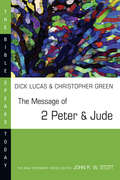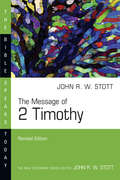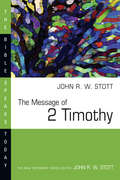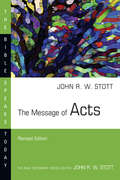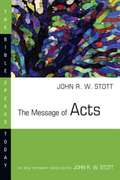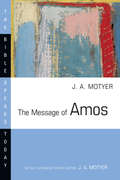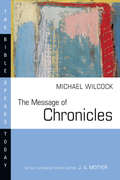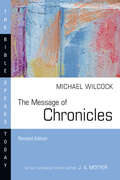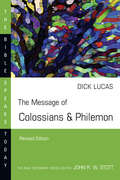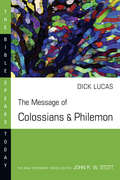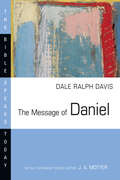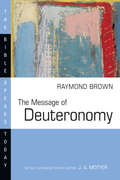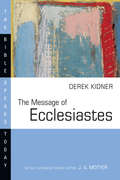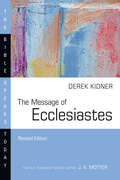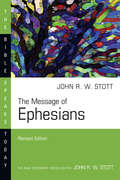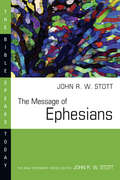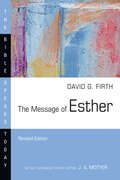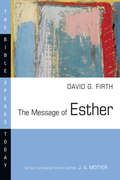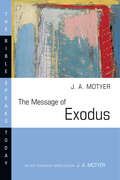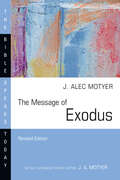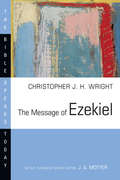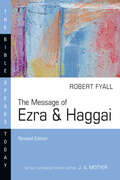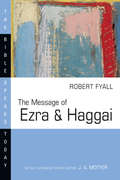- Table View
- List View
The Message of 2 Peter and Jude (The Bible Speaks Today Series #Vol. 2)
by Christopher Green R. C. LucasThe letters of 2 Peter and Jude are sometimes overlooked, yet their message for today's church is timely and compelling. Today, as in the first century, Christians must guard against false guides who lead young believers astray and cause divisions within the community of faith. Responding to this ever-present danger, 2 Peter and Jude equip readers to discern truth from illusion and exhort them to loyalty, harmony and spiritual maturity. In this volume of the Bible Speaks Today series, Dick Lucas and Christopher Green offer passage-by-passage exposition of the letters of 2 Peter and Jude. They include introductory information on authorship, original audience, major themes and recent issues of scholarship, while focusing on the relevance of these two letters to contemporary Christian experience.
The Message of 2 Timothy (The Bible Speaks Today Series)
by John StottAfter teaching many times from the book of 2 Timothy, John Stott writes, "I have been impressed afresh by the timeliness for today of what the apostle writes, especially for young Christian leaders. For our era too is one of theological and moral confusion, even of apostasy. And the apostle summons us, as he summoned Timothy, to be strong, brave and steadfast." In this revised Bible Speaks Today volume, Stott explores the perennial lessons of Paul's final epistle. We see Paul call the young leader Timothy to courageously persevere in the truth and in his calling, not yielding to the pressures of public opinion or the surrounding culture. Highlighting key themes such as guarding, proclaiming, and suffering for the gospel, Stott also considers the historical background and applications for readers today. This revised edition of a classic Bible Speaks Today volume includes updated language and Scripture quotations and a new interior design.
The Message of 2 Timothy: Guard The Gospel (The Bible Speaks Today Series)
by John StottJohn Stott writes, "During the last five years I seem to have lived inside the second letter of Paul to Timothy. In imagination I have sat down beside Timothy and have tried myself to hear and heed this final charge from the aging apostle . . . "On each occasion I have been impressed afresh by the timeliness of today of what the apostle writes, especially for young Christian leaders. For our era is one of theological and moral confusion, even of apostasy. And the apostle summons us, as he summoned Timothy, to be strong, brave and steadfast."
The Message of Acts: The Spirit, The Church And The World (The Bible Speaks Today Series)
by John StottThe Spirit moves the church into the world. That is how it has always been since the day of Pentecost, when the Spirit brought thousands from many countries into the body of Christ. With the breadth and scholarly care that marked John Stott's years of ministry, this revised Bible Speaks Today volume opens to us the early days of the church as recorded by Luke in the book of Acts. The experiences of the early church have much to say about issues that concern Christians today. What can Acts tell us about tongues and other extraordinary manifestations of the Spirit? How should churches structure themselves—with elders, deacons, pastors or all three? What should a normal Christian conversion look like? And, of course, how should the church reach out into the world with the message of salvation? This revised edition of a classic Bible Speaks Today volume features lightly updated language, current NIV Scripture quotations and a new interior design. A study guide at the end of the book will help you more deeply ponder the message of Acts and how it speaks to your life.
The Message of Acts: The Spirit, the Church and the World
by John R. W. StottThis book opens to us the early days of the church as recorded by Luke in the book of Acts. What can Acts tell us about tongues and other extraordinary manifestations of the Spirit? How should churches structure themselves? What should a normal Christian conversion look like? And, how should the church reach out into the world with the message of salvation? These and many other topics are handled with a commitment to the authority of God's Word in our lives.
The Message of Acts: To The Ends Of The Earth (The Bible Speaks Today Series)
by John StottA 1991 Christianity Today Readers' Choice Award The Spirit moves the church into the world. That is how it has always been since the day of Pentecost when the Spirit brought thousands from many countries into the body of Christ. With the breadth and scholarly care that have marked John Stott's years of ministry, this book opens to us the early days of the church as recorded by Luke in the book of Acts. The experiences of the early church have much to say about issues that concern Christians today. What can Acts tell us about tongues and other extraordinary manifestations of the Spirit? How should churches structure themselves--with elders, deacons, pastors or all three? What should a normal Christian conversion look like? And, of course, how should the church reach out into the world with the message of salvation? These and many other topics are handled with a pastoral heart and an unwavering commitment to the authority of God's Word in our lives. As Stott concludes, "The Acts of the Apostles have long ago finished; the acts of the followers of Jesus will continue until the end of the world."
The Message of Amos (The Bible Speaks Today Series)
by J. Alec Motyer"Affluence, exploitation and the profit motive were the most notable features of the society which Amos observed and in which he worked . . . "Standards had gone to pot. Authority and the rule of law were despised, and national leadership, while reeling in the publicity and dignity of position . . . Seemed to be contributing to the complete breakdown of law and order." Thus J. A. Motyer exposes and explains the astonishingly relevant--but never popular--message of the prophet Amos. Michael Green says, "Alec Motyer has clearly got the spirit of Amos in his blood. He loves the prophet from Tekoa, and takes endless pains to give full weight to every syllable of the prophecy. He is, of course, a distinguished scholar, and we are given full value on that front; but you will find here none of the dreary academic deadness which all too often comes through in commentary work."
The Message of Chronicles (The Bible Speaks Today Series)
by Michael WilcockMichael Wilcock sees Chronicles as first and foremost a sermon; its object -- to foster a right relationship between God and his people. The Chronicler finds in the records of Israel the "great overall pattern" of God's hand in history. The Lord's constant mercy, love and faithfulness shine through. With great perception, the Chronicler first selects and then proclaims this vibrant pattern, highlighted in the living events of the nations's actual hsitory. Once its purpose is grasped, the book comes alive. It can be seen as nothing less than a final and momentous look back over the entire Old Testament. Viewed in this way, Chronicles has something of the vividness, contrast and drama of the last book of the New Testament, Revelation. Michael Wilcock sees the countless persons named and chronicled as part of one people of the living God. They make vivid to us the truths by which the Lord's people in every generation are to live.
The Message of Chronicles (The Bible Speaks Today Series)
by Michael WilcockMichael Wilcock sees Chronicles first and foremost as a sermon. Its object: to foster a right relationship between God and his people.The Message of Chronicles
The Message of Colossians & Philemon (The Bible Speaks Today Series)
by Dick LucasEven healthy churches are never completely immune to the intellectual and spiritual pressures of their time. The church in Colossae was no exception. False teaching shaped by the spirit of the age was rising within the community, suggesting that a fuller knowledge and freedom was available beyond what ordinary Christians had experienced. Paul’s response was adamant: all God's fullness is in Christ alone, and everyone who is in Christ shares in his triumph. The epistle to the Colossians is filled with teachings and warnings that are relevant to the church in every era. In this revised Bible Speaks Today volume, Dick Lucas identifies key themes of Paul's letter and considers applications for today. Guiding readers through each passage, Lucas explores the great truths of the faith packed into Colossians: freedom, victory over evil, knowledge of God, unity, and other aspects of the riches available in Christ. This new edition of a classic BST volume includes a new interior design, lightly updated language, and updated Scripture quotations throughout.
The Message of Colossians & Philemon (The Bible Speaks Today Series)
by R. C. LucasFullness and freedom--two aspects of Christian life that we all want to share. Paul wrote about them at length (and depth) in his letter to the Christians at Colossae, where certain new teachers were proclaiming that "mere Christianity" is not enough. There is, they suggested, a fuller experience, a greater liberation, than they had so far enjoyed. But Paul was adamant: all God's fullness is in Christ alone, and only through his complete work are we set free. These are the great objective truths of the faith that Dick Lucas highlights in his exposition, enabling us to see both the riches that are ours in Christ and the irrelevance--even blasphemy--of all would-be improvements on what God has done.
The Message of Daniel: His Kingdom Cannot Fail (The Bible Speaks Today Series)
by Dale Ralph DavisPreaching's Preacher's Guide to the Best Bible Reference for 2014 (Old Testament Commentaries) From former pastor and professor Dale Ralph Davis, this replacement volume in the Bible Speaks Today Old Testament commentary series offers a reliable exposition of the visionary book of Daniel for pastors and lay commentary readers. Explaining the background to Daniel, he sifts through interpretive issues and then offers a faithful exposition of the book's message.
The Message of Deuteronomy (The Bible Speaks Today Series)
by Raymond BrownReading Deuteronomy can be like standing before Israel with Moses, hearing him address us as a future generation of the covenant people of God. Though we may have passed over the Jordan into the good land, we still struggle with temptations and opposition. Raymond Brown's The Message of Deuteronomy guides Christians to hear and appreciate the timeless relevance of this message from the Plains of Moab. His compilation of impertant historical and biblican background complements his even-handed, penetrating commentary without overwhelming his readable style. A great gift for the experienced and the beginning Bible reader.
The Message of Deuteronomy (The Bible Speaks Today Series)
by Raymond BrownNo Old Testament book has exerted a greater influence on the formation of both Jewish and Christian thought and practice than Deuteronomy. It presents the final message of Moses to the people of Israel, providing foundational theology for the rest of Scripture. When we read Deuteronomy today, we hear Moses address us as a future generation of the covenant people of God. The challenges and needs faced by the Israelites still resonate with believers in every new era. Raymond Brown's The Message of Deuteronomy guides Christians to hear and appreciate the timeless relevance of this ancient message. Brown's compilation of historical and biblical background complements his even-handed, insightful commentary while maintaining a readable style. Uncover the choice between blessings and curses, life and death laid out in Deuteronomy. This revised edition of a classic Bible Speaks Today volume features lightly updated language, current NIV Scripture quotations, and a new interior design.
The Message of Ecclesiastes (The Bible Speaks Today Series)
by Derek KidnerWhat is life about? In the end, does it all amount to a wisp of vapor, a puff of wind, a mere breath—nothing you can get your hands on—the nearest thing to zero? So says the Preacher in the book of Ecclesiastes. But is this the whole message of Ecclesiastes? With imagination and clarity, Derek Kidner introduces this Old Testament book which speaks so powerfully to our generation. His love of Hebrew poetry and his understanding of biblical mind shine through in his careful passage-by-passage exposition. The full biblical text is included.
The Message of Ecclesiastes: A Time to Mourn and a Time to Dance (The Bible Speaks Today Series)
by Derek KidnerWhat is life all about? In the end, is it no more than a wisp of vapor, a puff of wind, a mere breath? So says the Preacher in the book of Ecclesiastes. But is this the whole message of Ecclesiastes? With imagination and clarity, Derek Kidner introduces this unusual Old Testament book that speaks so powerfully to each new generation. He reveals how the Preacher confronts difficult questions and examines extremes of human experience, facing the fear that God is distant and nothing has meaning. Finally, however, we are led to encounter the God who was present all along, who cares about the details of our lives. Part of the beloved Bible Speaks Today series, The Message of Ecclesiastes offers an insightful, readable exposition of the biblical text and thought-provoking discussion of how its meaning relates to contemporary life. Used by students and teachers around the world, the Bible Speaks Today commentaries are ideal for those studying or preaching the Bible and anyone who wants to delve deeper into the text. This revised edition of a classic volume features lightly updated language and current NRSV Scripture quotations with a new interior design.
The Message of Ephesians (The Bible Speaks Today Series)
by John StottA common blind spot for evangelical Christians is to overlook the central importance of the church, emphasizing individual salvation more than the saved community. Yet no one can come away from a careful reading of Ephesians with a privatized gospel. Paul's letter to the Ephesians clearly sets forth God's eternal purpose to create the church—God's new society. In this revised Bible Speaks Today volume, John Stott expounds Paul's theme of uniting all things in Christ by uniting his church. Guiding readers passage by passage through Ephesians, he provides helpful background, highlights key themes, and offers applications for Christians today. Drawing from his many years of studying and teaching Ephesians, Stott lays out the book's compelling vision of what the church should be and its ongoing need for renewal. Christians are called to new life, new standards, and new relationships within the new society, where God breaks down all the barriers that have divided us from God and each other. This revised edition of a classic volume features a new interior design, updated Scripture quotations, and light updates throughout.
The Message of Ephesians: God's New Society (The Bible Speaks Today Series)
by John StottMillions have caught Karl Marx's vision of a New Man and a New Society. "Paul presents a greater vision still," writes John Stott. In his letter to the Ephesians the apostle "sees the human predicament as something even deeper than the injustice of the economic structure and so propounds a yet more radical solution. He writes of nothing less than a 'new creation.'" John Stott expounds Paul's theme of uniting all things in Christ by uniting his church and breaking down all that seperates us from God, one ethnic group from another, husband from wife, parent from child, master from slave. A book for all who want to build the church into the new society God has planned it to be.
The Message of Esther (The Bible Speaks Today Series)
by David G. FirthThe book of Esther tells the dramatic story of how the destruction of the Jews was averted through the bravery of Esther, the wisdom of Mordecai, and the unity of the Jewish people.Nevertheless, Esther does have a developed theology. In this BST volume, David Firth explores this paradoxically important book and its implications for our own context, where the reality of God's presence is experienced against a backdrop of God's relative anonymity and seeming absence. Using brilliant satire and subtle scriptural allusions, the book of Esther offers us a model for dealing with a world where Christians are frequently a minority voice. It calls us to courageously engage society and be at the forefront of standing for justice, all while trusting in the God who is always at work.The Message of Esther offers
The Message of Esther: God Present But Unseen (The Bible Speaks Today Series)
by David G. FirthBy any assessment, Esther is a rather strange book to find in the Bible. Not only is it, along with Daniel, the only book of the Bible to be set entirely outside of the Promised Land, it also shows no interest in that land. More than that, Esther is the only book in the Bible which definitely does not mention God. None of this should be taken as meaning that the book has no theological intention--on the contrary it has a developed theology, but it is a theology which operates precisely because it does not mention God directly. In this volume in the Bible Speaks Today commentary series, David Firth explores this paradoxically important book and its implications for our own contemporary context, where the reality of God's presence is experienced against a backdrop of God's relative anonymity and seeming absence.
The Message of Exodus: The Days of Our Pilgrimage (The Bible Speaks Today Series)
by J. A. MotyerWhen the Lord promised the land of Canaan to Abram and his descendants (Gen 15:7), every part of it was already occupied by other peoples. The long journey to possession of the Promised Land was prepared by God, yet it led through a path of adversity. We, the readers of the Old Testament, are left to wonder why. In this engaging Bible Speaks Today commentary on Exodus, J. Alec Motyer explores the character of God through his covenant promises and persistent faithfulness to the people of Israel. Through the story of Israel we are exposed to an unquenchable fire: God the Savior, the Companion and the Indweller, who will not fail those who so often fail him.
The Message of Exodus: The Days of Our Pilgrimage (The Bible Speaks Today Series)
by J. Alec MotyerThe whole story of the book of Exodus is a covenant narrative. In Moses' story, the pledges that God made to Abraham are honored and fulfilled as the Israelites are saved from Egypt and guided to the promised land. In this Bible Speaks Today volume, J. Alec Motyer explores what this key part of Scripture testifies about the God of the Bible. Considering the meaning that Exodus still has for us today, he unfolds the ways it points to Jesus Christ and heralds him in advance. Exodus reveals much about the faithfulness of God and the nature and life of God's people—their redemption, obedience, security, and inheritance. Part of the beloved Bible Speaks Today series, The Message of Exodus offers an insightful, readable exposition of the biblical text and thought-provoking discussion of how its meaning relates to contemporary life. Used by students and teachers around the world, The Bible Speaks Today commentaries are ideal for those studying or preaching the Bible and anyone who wants to delve deeper into the text. This revised edition of a classic volume features lightly updated language, current NIV Scripture quotations, and a new interior design.
The Message of Ezekiel: A New Heart and a New Spirit (The Bible Speaks Today Series)
by Christopher J. WrightEzekiel comes to us as a stranger from a distant time and land. Who is this priest who, on his thirtieth birthday, has a dazzling vision of God on a wheeled throne? Who is this odd prophet who engages in outlandish street theater and speaks for God on international affairs? Who is this seer who paints murals of apocalyptic doom and then of a restored temple bursting with emblems of paradise? Are we bound to take this literally, reading prophet and newspaper side by side? Or is there a better way? Christopher Wright is a proven interpreter and communicator of the Old Testament, and in this commentary he masterfully opens our eyes to see and understand the message of Ezekiel. Ezekiel's vision of the glory of God--its departure and return--is first set within Israel's history and then in the culmination of God's promises in Christ. Embedded in the pattern of the strange, the bizarre and the wonderful is a word that still speaks to God's people today.
The Message of Ezra & Haggai (The Bible Speaks Today Series)
by Robert FyallFew sermons or Bible studies focus on Ezra or Haggai, two brief Old Testament books named for relatively unknown figures.
The Message of Ezra & Haggai: Building For God (The Bible Speaks Today Series)
by Robert FyallEzra is rarely if ever preached on. Haggai gets even shorter shrift: if anything, Haggai 1 is pressed into service to encourage a reluctant congregation to give to an ailing fabric fund. But the message of these books, and their emphasis on building for God and the need of obedience to his Word and openness to his Spirit, is one which needs to be heard clearly today. This commentary by Robert Fyall highlights the contemporary parallels of the challenges Israel faced to those of today's church and demonstrates the relevance of the books of Ezra and Haggai for God's people in all times. With passage-by-passage exposition of the biblical text, this resource will be helpful for pastors, teachers and anyone who wants to dive deeper into these seldom discussed Old Testament books.
